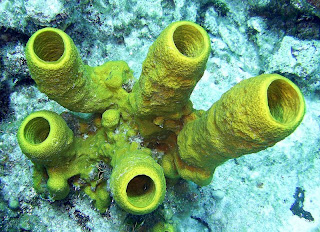Extremely ancient animals, sponges have displayed following Precambrian times, 540 million years ago, and have changed little since that time. The familiar bathroom sponge is made from a sponge skeleton.
Sponges exist principally connected to the seabed. They are upheld by a skeleton lying among the external and inward layer of units of the form. The skeleton is made of calcium carbonate, spongin (a protein) or glasslike silica, depending to the type of sponge. The large number of hard skeletal parts in sponge bodies means there are many fossils to explore.
 Friends and Neighbors
Friends and Neighbors Sponges often live closely with other organisms. Some species associate with tiny algae that are taken in with sea water. The algae are not eaten by the sponge, so they are able to photosynthesize (make food using the energy from sunlight). They handle carbs that assistance furnish nourishment for the sponge accommodate. Glass sponges; ones with silica skeletons; trap passing invertebrates that become caught on glassy projections on the skeleton. The impaled prey is digested by amoebalike cells within the sponge body.
Sponges often live closely with other organisms. Some species associate with tiny algae that are taken in with sea water. The algae are not eaten by the sponge, so they are able to photosynthesize (make food using the energy from sunlight). They handle carbs that assistance furnish nourishment for the sponge accommodate. Glass sponges; ones with silica skeletons; trap passing invertebrates that become caught on glassy projections on the skeleton. The impaled prey is digested by amoebalike cells within the sponge body.







0 comments:
Post a Comment